Recent Biohazard Posts
The 5 Levels of Hoarding and How to Recognize the Disorder
8/2/2021 (Permalink)
 Depending on the severity, hoarding can impact a person’s physical and emotional health, relationships, financial and legal stability.
Depending on the severity, hoarding can impact a person’s physical and emotional health, relationships, financial and legal stability.
An estimated two to six percent of the US population suffers from hoarding disorder. Hoarding can create unsafe conditions for people and pets who live in the household.
At SERVPRO of North Richland Hills, our cleaning and restoration professionals understand the sensitive situations involved in hoarding. Contact us day or night for a free estimate on our emergency cleaning services at (817) 589-1499.
What Are the Levels of Hoarding?
People with hoarding disorder have a compulsive drive to find and keep objects, animals, and even trash — regardless of need or the item’s value. Some of the most commonly hoarded things are:
- Magazines and newspapers
- Photos
- Clothing
- Boxes
- Food
- Paper
- Bags
- Furniture
- Appliances and electronics
Depending on the severity, hoarding can impact a person’s physical and emotional health, relationships, financial and legal stability. The disorder is categorized into five levels, with five the severest manifestation of the condition.
Level 1 Hoarding
Hoarding level one is the least severe form of the disorder and can be difficult to recognize until it reaches more severe levels. At this level, you’ll find:
- Some clutter and no discernable odors
- Doors and stairways are accessible
- Three or fewer areas with animal waste in the home
The lack of odors and clutter can be misleading. But in this level of hoarding, the individual may have trouble throwing away items and excessively shop.
Level 2 Hoarding
At this level, there is more visible clutter, odor, and grime in the home.
- Light odor
- Animal waste on the floor
- Evidence of rodent or insect infestation
- Overflowing trash bins
- Unclean food preparation surfaces
- At least one blocked exit
- Non-working appliance for at least six months
Hoarding level 2 sufferers are often embarrassed at the state of their home and avoid visitors. They may also be anxious or depressed.
Level 3 Hoarding
Level 3 hoarding involves clutter outdoors, typically broken appliances and furniture.
- At least one unusable bedroom or bathroom
- Spills and stains on floors and surfaces
- Excessive dust and debris
- Dirty towels, clothing, and sheets
- Tangled cords from blocked electrical outlets
- Noticeable odor
- Pest infestations
- Animal feces throughout the home
Poor personal hygiene is often present in level 3 hoarding.
Level 4 Hoarding
Homes in this hoarding level will have noticeable mold and odor, along with structural damage. Sewage backup is also a possibility. Animal hoarding may also be an issue with hoarding level 4.
- Rotting and expired food
- No clean dishes or eating utensils
- Rodents and bugs
- Unusable bedrooms and bathrooms
- No clean bed sheets or no bedding present
- More than one blocked doorway and blocked exits
- Unsafe substances stored in living areas
- Excessive odor
- Noticeable animal waste
Sadly, people with level 4 hoarding will often experience health problems related to unsafe and unhygienic living situations. They may not bathe or shower for weeks and have worsening mental health.
Level 5 Hoarding
Structural damage to the house is typically present in the most severe manifestations of hoarding disorder. Lack of electricity and running water, and fire hazards are also common in level 5 hoarding.
In addition to the signs present in level 4 hoarding, other symptoms may include:
- Animal and human waste throughout the home
- Clutter throughout the house, resulting in narrow pathways
- Unusable kitchens, bedrooms, and bathrooms
- Non-working appliances, including HVAC and refrigeration
People with level 5 hoarding can also suffer from clinical depression.
Hoarding Aftermath
Hoarding is a severe disorder, and homes in these conditions typically require professional biohazard cleanup and restoration.
At SERVPRO of North Richland Hills, we can repair and restore homes to livable condition. Contact our Fort Worth at (817) 589-1499 24/7 for a free cleaning bid on our Biohazard Cleaning Services.
How to Safely Dispose of Biohazard Waste in Fort Worth, TX
2/5/2021 (Permalink)
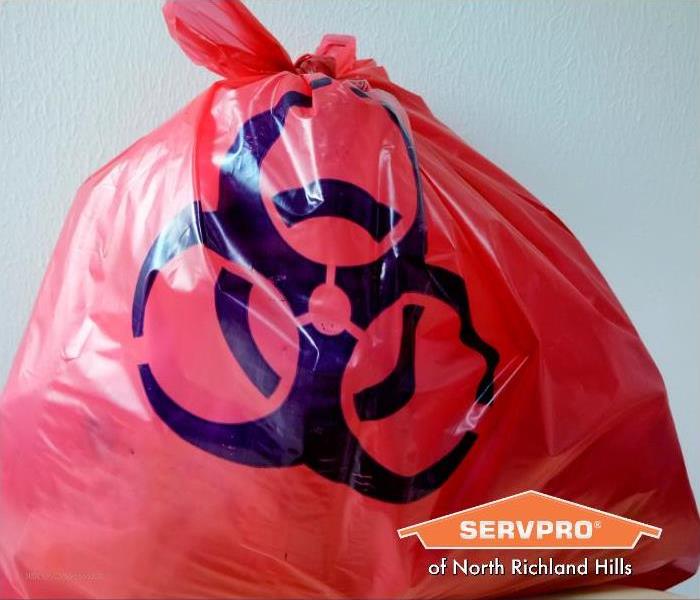 If you're unsure of how to properly dispose of biohazard waste, call the experienced biohazard cleanup professionals at SERVPRO in Fort Worth.
If you're unsure of how to properly dispose of biohazard waste, call the experienced biohazard cleanup professionals at SERVPRO in Fort Worth.
Did you know that the official website for Fort Worth, TX features a waste sorting game? This game reminds citizens that not all waste goes to the same place.
While accidentally putting a banana peel in the recycling bin is a harmless mistake, placing biohazard waste where it doesn’t belong is not only illegal but also threatens public health.
Unless you have experience dealing with biohazard waste and access to the proper supplies, you should refrain from doing biohazard cleanup. For your safety and the safety of others, it’s best to leave biologically hazardous waste alone so that the professionals can handle it.
What is the Definition of Biohazardous Waste?
Biohazards are any biological material that poses a threat to animals or humans. Biohazards can be present in any environment.
Biohazard waste is any refuse that contains biologically toxic materials or substances that may be infectious (like blood). Because of the risk of disease associated with biohazard waste, any biohazard cleanup should be handled vigilantly.
What is Considered Medical Biohazardous Waste?
Because clinics, hospitals, and labs must obtain and analyze specimens from humans and animals, they will generate medical waste. Not all medical waste qualifies as a biohazard, but some may assume that it is.
For medical waste to be a biohazard, it would have to be infectious or potentially infectious. This means that materials made contact with blood, bodily fluids, or human cell lines.
Medical waste that is classified as biohazardous poses a threat to the environment and public health. Below are some examples of biohazardous medical waste:
- “Sharps” - hypodermic needles, blades, or slides.
- Cultures, Petri dishes, and other culture flasks that are biologically contaminated.
- Any biologically infectious agents.
- Some bacteria
- Some viruses
- Some spores
- Live or attenuated vaccines.
- Materials that made contact with excretion, exudates, or secretions from bodies infected with an illness.
- Any paper products or wipes that have become contaminated by biohazardous materials.
- Human or animal blood, blood elements, fluids, or semi-fluids.
- Specimens from the human body.
- Animal carcasses or body parts that are considered dangerous.
Medical facilities are equipped with the appropriate receptacles marked for biohazard waste disposal.
Examples of Biohazardous Waste
Understanding the nature of biohazardous waste helps you better understand how to best handle its disposal.
Biohazardous waste usually falls into one of the following categories:
- Blood - Blood from humans or tissue that contains human blood.
- Animal - The whole or a part of a decaying animal carcass.
- Bodily fluids - Fluids and secretions from the human body.
- Microbiological - Lab materials such as specimen cultures, culture dishes, viruses, and any devices used for the transfer or mixing of cultures.
- Pathological - Medical biopsy materials, or anatomical parts that were removed via medical procedures.
- “Sharps” - As described earlier, any sharp materials that make contact with biological materials such as blood.
Four Levels of Biohazard Waste
Just as someone would need to know the type of biohazard material they are dealing with, they would also need to understand the level of risk.
Four levels of biohazard waste have been established so that those who are tasked with handling biohazardous materials understand how much caution is warranted. This helps with training those who do biohazard waste disposal on a routine basis.
- Biohazard Level I: Considered to be a minimal threat, but nonetheless, any biological agent that would bring harm to humans or the environment. Examples: E. coli., Bacillus subtilis, or Naegleria gruberi.
- Biohazard Level II: Considered to be a moderate threat, any biological agent that has the potential to cause severe illness in humans. Such disease would be transmitted through direct contact with the infected material. Examples: Hepatitis B, HIV, or Salmonella.
- Biohazard Level III: Considered to be a contagious threat, any pathogen that has the tendency to become airborne and would cause severe illness or disease. Examples: Tuberculosis, Coxiella burnetii, etc.
- Biohazard Level IV: Considered to be the highest risk to living beings, any pathogen known to cause a life-threatening disease for which there is no cure. Examples: Ebola virus, Lassa virus, etc.
The greater the level of risk, the more important it is for a well-trained professional to approach the biohazardous materials.
How to Dispose of Biohazard Waste
Two elements are needed to dispose of biohazardous waste properly: persons who are trained on best practices for biohazard disposal, and access to adequate biohazard disposal supplies on hand.
- Solid waste - Any material that makes contact with human or animal specimens that is not a “sharp.”
Examples: Linens, towels, or used personal protective equipment. This waste is disposed of as regular medical waste and will be sent to a special landfill. Healthcare workers dispose of these in a designated container lined with an autoclave bag with each marked with a biohazard symbol. - Liquid waste - Body fluids or blood that may carry an infectious agent. These are placed in a leakproof container (specified by a hazard label) installed securely so it won’t fall over. For added security, these are sometimes placed into an additional container. Autoclaving or bleach treatment may be applied in the presence of a liquid biohazard (except for body fluids or chemical waste).
- “Sharps” waste - Medical instruments are thought to be infectious but are also sharp enough to pierce through a plastic bag (needles, microscope slides, scalpels, and broken glass vials). To protect people and animals from injury, these are kept in a container that is resistant to puncture, leakproof, and properly labeled. “Sharps” receptacles will be picked up by a medical waste service provider to be transported to an incineration facility.
- Pathological waste - Organs, tissues, and body parts that were removed from a human or animal (such as biopsy material) and may contain infectious agents. To prevent leaks, this waste should be double-bagged and then stored in a secondary container. These are also bound for the incinerator.
- Microbiological waste - Culture dishes and specimen cultures, discarded viruses, or devices used to mix cultures from a laboratory that would possibly contain infectious agents or other pathogenic organisms. These materials can be either sanitized onsite by trained personnel or properly disposed of in a storage area designated for biohazard waste.
Biohazard waste receptacles should be marked with the appropriate symbols so they aren’t mixed in with or mistaken for other kinds of refuse. These marked bags and containers are then picked up by a professional medical waste company.
The final destination of biohazard waste is an industrial incinerator where these materials can be destroyed so they will no longer pose a threat to life and health. In many cases, incineration is required by health mandate, but some materials are allowed to be remediated with disinfection, chemical treatment, or autoclaving.
Contact SERVPRO for Fort Worth Biohazard Cleanup and Disposal
When in doubt, do not attempt to clean up biohazard waste on your own. The greater the risk level associated with the materials, the more likely it is that trained professionals are needed to ensure the safety and well being of everyone involved.
SERVPRO of North Richland Hills has extensive experience with Fort Worth biohazard cleaning scenarios. Our trained technicians know how to approach biohazardous and infectious waste and will dispose of these toxic materials safely and securely.
We specialize in the following biohazard situations:
- Crime scene cleanup or unattended death (Examples: homicides, suicides, accidental death, meth labs, tear gas, etc.).
- Cases of C Diff
- Homes affected by hoarding
- Residential or commercial sewage backup or chemical spills
- Property contamination from animals (such as a rodent infestation).
Many of the above scenarios are of a sensitive nature. We understand why clients would not want attention drawn to their property in these situations, so we are prepared to carry out biohazard cleaning services with discretion. One of the ways we do this is to schedule the cleaning for overnight when it’s least likely to be noticed.
If you have an overwhelming biohazard situation on your hands, don’t risk it. We have the right training and all the materials needed to handle the biohazard situation so that everyone remains safe and sound. Call SERVPRO of North Richland Hills for 24/7 emergency contact at (817) 589-1499.
How to Clean House After C-Diff Infection
9/16/2020 (Permalink)
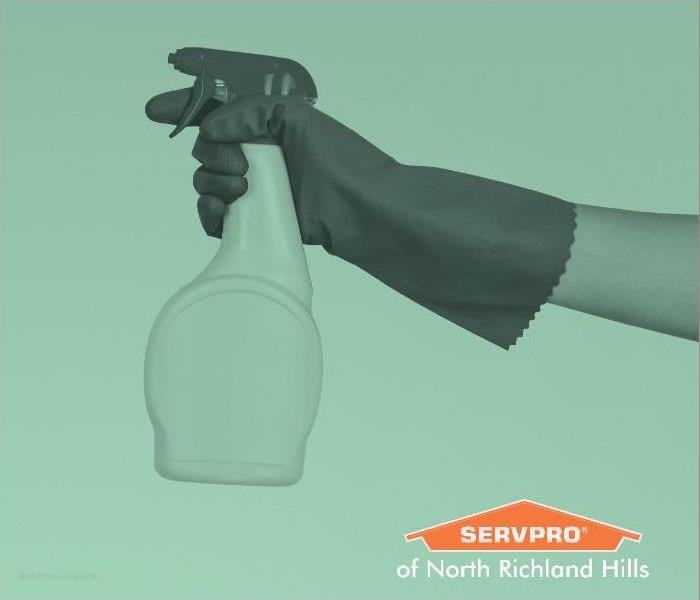 After dealing with a C. diff infection, it's important to thoroughly clean your home. Call the Fort Worth biohazard cleanup experts at SERVPRO today.
After dealing with a C. diff infection, it's important to thoroughly clean your home. Call the Fort Worth biohazard cleanup experts at SERVPRO today.
By now, the term “coronavirus” is a household name. The pandemic has elevated concerns about communicable diseases and has raised awareness of the importance of hygiene in prevention.
C. diff (clostridioides difficile) causes bacterial infections such as colitis or diarrhea. Because of how contagious and drug-resistant it is, C. diff is considered a public health concern by The Centers for Disease Control and Prevention.
SERVPRO is committed to safeguarding the Fort Worth community from viruses and harmful bacteria. We’ll instruct you on how to clean a house after C Diff infection. We’re also on call to assist with infectious disease emergencies year-round - even on weekends and holidays.
What is C. Diff?
C. diff is bacteria that can be found in fecal matter, soil, water, surfaces, and sometimes in food. This bacteria is part of the natural flora of a normal digestive system but does have the potential to become toxic.
Antibiotics can throw the body system off balance by killing off beneficial bacteria. Beneficial bacteria deficiency allows clostridioides difficile (C. diff) to overpopulate and become infectious. Spores from toxic C. diff that exit the body can make others ill.
C. diff causes colitis (inflammation of the colon). Bacterial toxins attack the lining of the intestines and cause illness. Symptoms begin to surface after a few days (or up to a few weeks) from the start of the infection.
Diarrhea for several days is the main symptom, but other signs of C. diff are fever, loss of appetite, nausea, or abdominal tenderness and pain. This infection has the potential to cause permanent colon damage and could become fatal.
Once a patient’s lab results come back positive for C. diff, the patient will be put on antibiotics for 10 days. Once the symptoms clear up, a patient may still be carrying the infected bacteria making them contagious or subject to reinfection.
In rare cases, surgery or fecal transplants may be necessary to treat those with repeat infections.
How Does C. Diff Spread?
Like other communicable diseases, C. diff spreads without adequate hygiene. The infectious bacteria exit the body through fecal matter. When particles from human waste end up on hands, objects, or land on surfaces they cause contamination that will make others sick.
The spread of C. diff can be mitigated by hand washing, disposing of contaminated materials, and communication between healthcare workers. Consistent and proper use of PPE is also a proactive measure to prevent the spread of infectious bacteria.
C. diff is a common biohazard found in healthcare facilities such as hospitals. Infected patients produce loose stools that allow the bacteria to scatter.
Because of how contagious this condition can be, it’s important to know how to clean a house after a C-diff infection.
C Diff Cleaning Procedures at Home
While this bacteria is known to be resistant to antibiotics and cleaners, there are steps you can take in disinfecting your house from C. diff.
C. diff can live on surfaces for up to five months. With this in mind, maintain proactive hygiene habits when someone in the home has been ill with C. diff. Continue to clean after the person has recovered.
Thoroughly clean the bathrooms or any other area of the house where an “accident” happened. As for C. diff cleaning products, hydrogen peroxide is considered to be most effective against clostridioides difficile bacteria.
Carefully dispose of soiled linens, clothing, etc. These items are contaminated and must be removed. Use PPE such as gloves to safely discard contaminated items.
Everyone in the household must wash their hands frequently. The bacteria may be lingering on surfaces. Handwashing is even more important when handling food.
Cleaning Recommendations to Prevent C-Diff Transmission
Because this infectious bacteria is so aggressive, it’s important to be consistent. Here are state agency recommendations for disinfecting your house from C. diff:
- Schedule routine cleaning and disinfection of all surfaces and materials plus air vents and carpets.
- Use an EPA-approved disinfectant from EPA List K.
- Using the appropriate dilution, apply cleaners with a clean cloth or spray bottle.
- When cleaning floors, replace mop water regularly.
- C. diff cleaning procedures for laundry include regular detergent but with the use of hot water (25 minutes wash at 160 °F). Bleach is optional.
Healthcare facilities should take additional sanitation precautions with shared equipment and when preparing rooms for new patients.
Contact the SERVPRO Professionals for Fort Worth for C-Diff Cleaning and Other Viruses
SERVPRO of North Richland Hills is your expert team for Fort Worth biohazard cleaning! Our technicians are specially trained to perform thorough and safe cleanup according to state and federal guidelines. In addition to C. diff cases, we’ve handled biohazardous situations involving:
- COVID-19
- Bloodborne pathogens
- Infectious disease
- Rodent infestation
- Trauma and Crime Scene Cleanup
- Suicide
- Unattended death
We are prepared to respond to any biohazardous emergency in the Fort Worth, Texas area. How to clean house after c-diff infection properly includes the appropriate personal protective equipment and the proper EPA-registered cleaners. Households may not have access to all the supplies needed, but we do! We’ll do a thorough and professional cleaning.
SERVPRO of North Richland Hills offers free consultations or free bids (completely confidential) for commercial properties. Make the first step in preventing the spread of C. diff now and call us at (817) 589-1499. We’re available 24/7.
Managing Mold
1/20/2020 (Permalink)
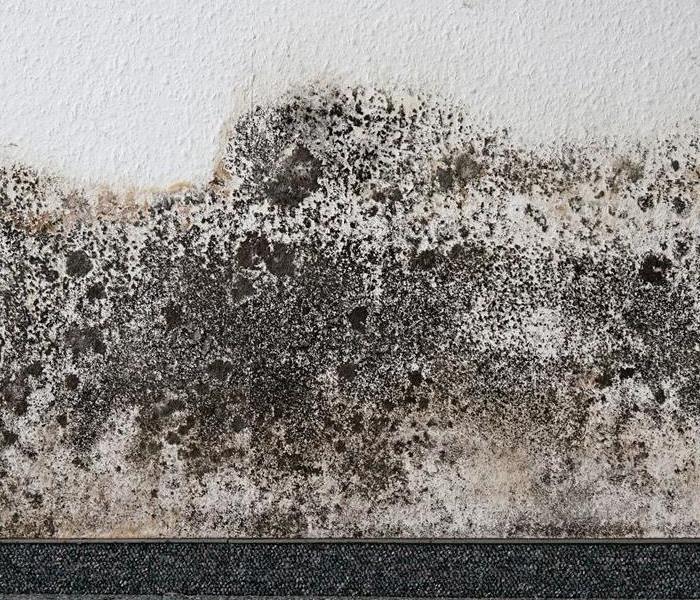 Although every mold damage scenario is different and requires a unique solution, the general mold remediation process stays the same.
Although every mold damage scenario is different and requires a unique solution, the general mold remediation process stays the same.
When there’s a water intrusion, like a roof leak or leaking water line, mold can quickly become a problem in your home or business. Mold can cause health effects and can also cause significant damage to your property. Fortunately, SERVPRO of North Richland Hills professionals have the training, protective gear, and specialized equipment necessary to handle your mold problem. Although every mold damage scenario is different and requires a unique solution, the general mold remediation process stays the same. The following steps illustrate a “typical” mold removal process.
Call the Team in Green
The mold cleanup and restoration process begins when you call SERVPRO of North Richland Hills. A representative will ask a series of questions to help determine the necessary equipment, resources, and personnel needed
Inspection and Damage Assessment
Your property will be carefully inspected for signs of mold using technology designed to detect mold and hidden water sources. Mold feeds on cellulose and water and can be hidden in plain view.
Mold Containment
Various containment procedures will be placed to prevent the spread of mold and isolate the contaminated area with physical barriers and negative air pressure to keep the mold spores from spreading during the cleanup process.
Air filtration
Specialized filtration equipment captures microscopic mold spores out of the air. Our technicians utilize powerful air scrubbers and HEPA vacuums to prevent the spread of these mold spores while the mold remediation is in progress.
Removing Mold and Mold-Infested Materials
The mold remediation process depends on the amount of mold growth and the types of surfaces on which mold appears. Antifungal and antimicrobial treatments will be used to eliminate mold colonies from forming. Removing and disposing of mold-infested porous materials, like drywall and flooring, may be necessary to remediate heavy mold growth.
Cleaning Contents and Belongings
SERVPRO of North Richland Hills can clean your furniture, decorative items, curtains, and other restorable items affected by mold. We use a variety of cleaning techniques to clean and sanitize your belongings. Our professionals are also trained to remove odors and deodorize using fogging equipment.
Restoration
Depending on the level of mold damage, drywall, subfloors, and other building materials may be removed. Restoration may involve repairs such as replacing drywall, painting, and installing new carpet; or it may entail major repairs such as the reconstruction of various areas or rooms in a home or business.
SERVPRO of North Richland Hills understands mold and mold growth and have the training and equipment to remediate mold in your home or business.
Biohazard, Crime Scene, and Vandalism Cleanup
1/14/2020 (Permalink)
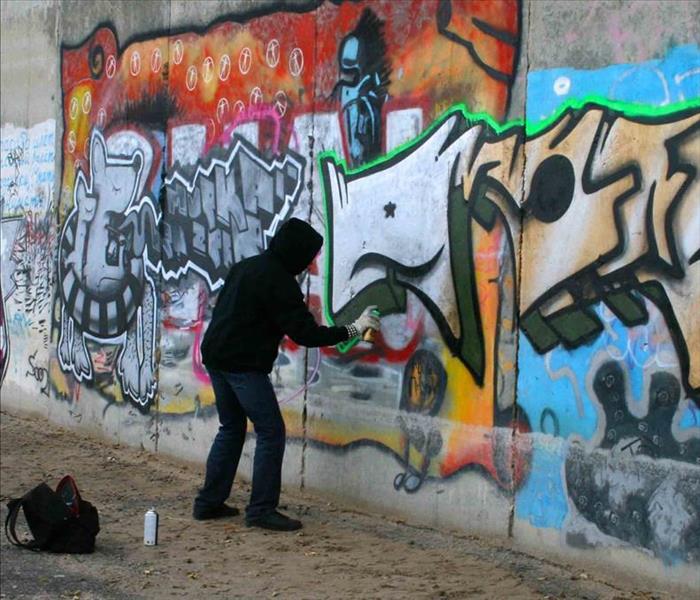 Failure to properly handle and safely remove such hazardous substances can contribute to unhealthy and even dangerous environments.
Failure to properly handle and safely remove such hazardous substances can contribute to unhealthy and even dangerous environments.
Recognized as a leading fire and water cleanup and restoration provider by hundreds of insurance companies, SERVPRO professionals also offer fast, reliable biohazard and crime scene cleanup and restoration services to residential and commercial property owners.
Exposure to biological and chemical contaminants can pose serious health consequences for building occupants, employees, customers, and owners. Failure to properly handle and safely remove such hazardous substances can contribute to unhealthy and even dangerous environments.
SERVPRO of North Richland Hills professionals are trained to safely and effectively remove biohazardous substances and prepare waste for proper disposal according to OSHA, EPA, and state and local health regulations.
Equipped with the necessary safety equipment and cleaning products, SERVPRO of North Richland Hills can help turn unsafe environments into clean, safe homes and offices by remediating the following services:
- Bloodbourne Pathogens
- Methamphetamine Labor
- Crime Scene Residues
- Arson
- Vandalism
- Sewage Backups
- Black Water Intrusions
- Mold Mitigation and Remediation
State and local regulations vary. Contact SERVPRO of North Richland Hills today for 24-hour emergency services.
Bloodborne Pathogens
SERVPRO Professionals remove and dispose of bodily fluids, tissue, and other potentially pathogenic substances resulting from accident, trauma, crime, or death. Trained SERVPRO technicians thoroughly clean, disinfect, and deodorize the structure.
Methamphetamine Labs
Many of the chemicals used in the production of illegal drugs, such as methamphetamine, are volatile and can leave harmful residues throughout a structure. SERVPRO of North Richland Hills professionals follow federal and state guidelines to properly clean all surfaces.
Crime Scene Residues
From fingerprint powder and evidence gathering chemicals to tear gas and pepper spray residues, SERVPRO can clean and restore your property and contents.
Arson and Vandalism
SERVPRO Franchise Professionals are recognized as leaders at helping property owners recover quickly from fire and water damage. SERVPRO of North Richland Hills also provides general cleaning and deodorizing services for situations resulting from vandalism including graffiti, eggs, spoiled foods and human or animal waste.
Category 1 Water Will Not Remain Clean
6/20/2018 (Permalink)
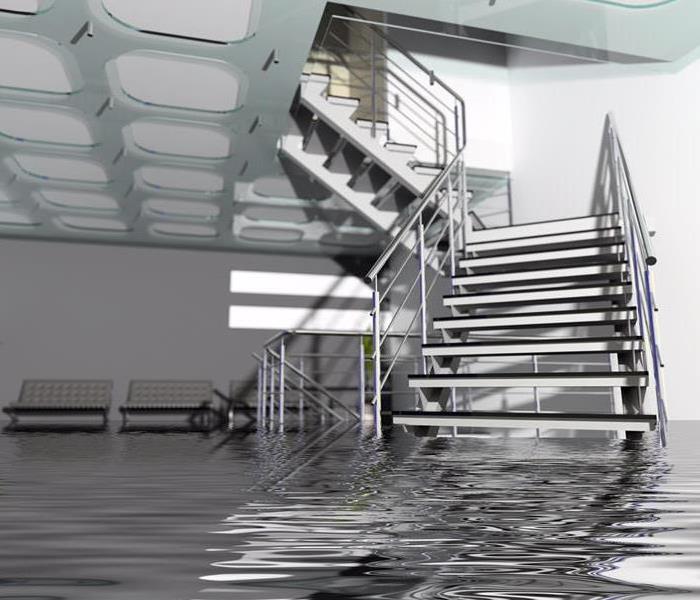 To additionally evaluate secondary water damage, it’s worth considering a professional water damage restoration crew.
To additionally evaluate secondary water damage, it’s worth considering a professional water damage restoration crew.
Water damage that comes from natural weather or any sanitary supply line is considered to be Category 1. While the water is from an uncontaminated source, it is still worth concern. Clean water threatens damage to commercial property. Understanding what it is, helps mitigate its severity.
Sources of Category 1 Water
Category 1 classification is for water that has a very low risk of starting out contaminated. It’s considered clean because it is either treated before use or naturally occurring. It can be from various sources:
• Broken pipe
• Defective faucet, toilet or sink
• Rainwater
• Melted snow
• Sprinkler system
• Overflowing commercial containers of sterile water
Categories of Water
Water is broken into categories depending on how dangerous cleanup will be. There are three different categories depending on severity. Category 2 and above pose an additional danger to health since those types contain harmful microorganisms. Category 1 is safe for people to be around but can damage the building if untreated.
Damage Caused by Category 1
While the water will not absorb or evaporate to heavily damage property, there are dangers of the damage escalating. As the water picks up contaminates from its surroundings, it can become more unhealthy and dangerous for everything to be around in as little as a day. If an odor that isn’t like tap water is in the air, the area probably has become contaminated and should be avoided until treated.
Valuable electronics and carpet can become damaged if not removed from the water. Precaution should be taken to ensure all movables are relocated somewhere dry and electronics remain nowhere near the water.
Treatment of the Damage
Clean water needs a cleanup. If desired, the affected property can be dried and carpeting can be cleaned by business owners or employees. To additionally evaluate secondary water damage, it’s worth considering a professional water damage restoration crew for your company in Richland Hills, TX. Making sure the damage has no larger implications can save money in the future. For more information, visit http://www.SERVPROnorthrichlandhills.com/.
Bio Cleanup in Fort Worth, Tx
4/26/2018 (Permalink)
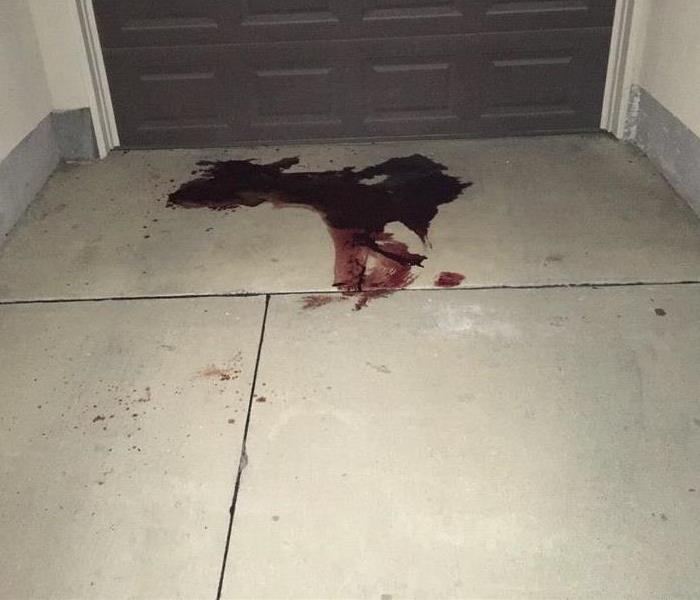 Bio cleanup, Fort Worth Texas
Bio cleanup, Fort Worth Texas
SERVPRO professionals remove and dispose of bodily fluids, tissue, and other potentially pathogenic substances resulting from accident, trauma, crime, or death. Trained professionals of SERVPRO of North Richland Hills thoroughly clean, disinfect, and deodorize the structure.
 Depending on the severity, hoarding can impact a person’s physical and emotional health, relationships, financial and legal stability.
Depending on the severity, hoarding can impact a person’s physical and emotional health, relationships, financial and legal stability.




 24/7 Emergency Service
24/7 Emergency Service




